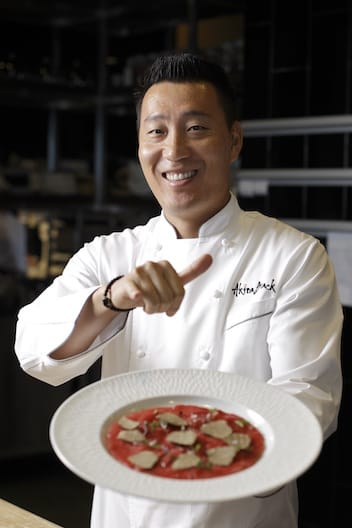Today, the charismatic chef goes by the name Akira Back and is chef and brand owner of more than a dozen eponymous restaurants in major cities from Dallas to Dubai, including one-MICHELIN-starred Dosa in Seoul and MICHELIN Plate restaurant Akira Back in Singapore.

He spent his first few years at the Japanese restaurant learning things the hard way, recalling that once, Kanada even made him count grains of sushi rice with chopsticks as penance for wasting rice. “He said I had no respect for the rice. But these days, I’m starting to understand why he taught me the way he did.”
Though Back spent seven years there training in Japanese cuisine, when it came time for him to express his own culinary style at Yellowtail Restaurant & Lounge in Las Vegas in 2008, he found himself injecting influences from his Korean-American roots into his modern Japanese cuisine.
One of the dishes to quickly become a signature on the Akira Back menu is the AB Tuna Pizza, which encapsulates the chef’s culinary ethos perfectly: sexy and easy to eat, served on custom plates printed with his mother’s abstract artwork. “The tuna pizza is my mum’s favourite dish, so I decided to put her art inside it. I want people to unveil a little more of the art underneath the pizza as they eat each slice and enjoy her art as they enjoy her favourite dish. While they’re eating it, I hope they think about their mothers too, that’s how I want to connect with my diners.”
RELATED: Ode To Mum: Chefs Whose Mothers Inspire Their Careers

Back’s confidence in his cuisine stems from a solid foundation in technique and a wide knowledge and respect for ingredients. “I think that technique is very important because if you understand technique, you can really design different things.”

“Having courage in the kitchen is simple. It’s just: ‘Do you really want to do this? Do you really love it?’ Because we care about quality and passion. Our team is passionate, I’m still passionate, that’s why we are here,” says Back. “I love cooking and I love developing new things, so I hope I can keep going. The day that I don’t have any ideas is the time that I have to do something else.”















